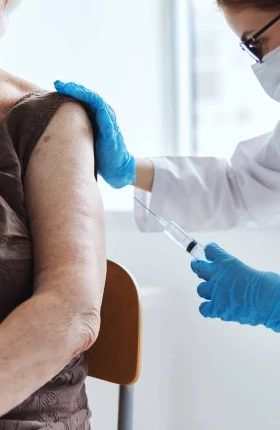As cases surge throughout much of the US and developing countries, the data is becoming increasingly clear about how to combat the coronavirus and safely reopen economies. In addition to wearing masks, limiting large indoor activities, and avoiding superspreader events, governments need to protect those whose health is most vulnerable through a package of policy interventions for people at home and at work.
About 20% to 30% of the global population is health vulnerable, although the percentages vary depending upon the region and country. In the US, for example, about 20% of the population has chronic health conditions, and about 10% is generally healthy but over the age of 65. By protecting those who are health vulnerable,governments can lower the burden on health care systems, many of which are now at risk of being overrun.
Below, we lay out a qualitative view of the policies needed to protect the health vulnerable. We will present a quantitative view that assesses the costs and benefits of each policy in a forthcoming article.
So far, governments have not done a good job at protecting people who are health vulnerable. In many settings, they are more likely to become infected than the general population. And when the coronavirus attacks the health vulnerable, they are more likely to tax the hospital system. For example, the most health vulnerable—those over age 65 with underlying conditions—are 60 times more likely to be hospitalized if infected than are healthy adults under the age of 50.
Home, Work, Money, and Behavior
Home and work remain the two primary avenues of infection for the health vulnerable, so policies need to protect them in both places. Our modeling shows that protecting the health vulnerable could reduce overall hospitalization levels by more than 50% and cost governments far less than they have spent to date. For instance, the US authorized $3 trillion in government support during the first three months of the pandemic. However, if the US spent $500 to $1,500 a month to protect each health-vulnerable individual, the monthly cost would have been $50 billion to $150 billion. With hospitalizations among this population cut in half, societies could more effectively manage the health consequences of the coronavirus and mitigate the risk of having to shut down a second time.
Our modeling shows that protecting the health vulnerable could reduce overall hospitalization levels by more than 50%.
Money alone is not enough. Governments also need to encourage a change in rhetoric and behavior. By designing smart programs and incentives, governments still have a chance to enable and encourage the health vulnerable to physically isolate, to wear masks and other protective equipment, and to be tested frequently. The opportunity to embrace these changes in behavior is quickly vanishing in the US and many developing countries.
The Health Vulnerable
We segmented the health vulnerable into four groups, given their risk of being infected either at work or home. (By home, we mean residences, including long-term care facilities, dormitories, prisons, and other congregate living settings.) As Exhibit 1 shows, the four groups are:
- People with a low risk of exposure in both places (a retired couple who lives by themselves, for example, or a working-age male with a heart condition who works from home)
- People with risk at home (a nursing home resident, a migrant worker living in a dorm, or a diabetic adult living with a frontline worker)
- People who cannot work from home (a hairdresser with respiratory issues, a medical staff member over the age of 65, or an immunocompromised factory worker with a long bus commute)
- People with risk at home who cannot work from home (a bus driver with a weakened immune system living in a multigenerational household where other members work outside the home)

The good news is that the largest of the four segments—made up of people who do not leave their residences to work and who live in low-risk households—is also the easiest to protect. However, in the US (and presumably elsewhere), the remaining three segments are collectively as large, and protecting them will be more challenging.
Countries are starting to create policies to protect the health vulnerable in these settings. The UK, for example, is providing food and mental health support to encourage sheltering in place among those who are safe at home and who do not work outside the home. South Korea has established a national monitoring system to keep residents at long-term care facilities healthy, while China requires health screenings in workplaces.
In many countries, these policies were put in place catch-as-catch-can, and despite good intentions, these policies have not necessarily seen wide-scale success. Now is the last best chance to modify these policies, connect with hard-to-reach immigrant and minority populations, and encourage those who have the greatest risk of exposure to shelter in place and practice interacting safely.
A Policy Prescription
We identified a package of five policies that collectively work toward protecting the four groups of the health vulnerable. (See Exhibit 2.)

Eliminate work-exposure risk. As lockdown orders have expired, workers have returned to jobs that demand a physical presence, such as those in stores, factories, meatpacking plants, agricultural fields, offices, restaurants, amusement parks, and so forth. Protecting health-vulnerable employees in these settings requires cooperation between the public and private sectors, as demonstrated by the outbreak in Europe’s largest meatpacking plant in Gütersloh, Germany. The failures of the private sector to protect workers and the missteps of the public sector to enforce worker safety boomeranged back to the general public, which was forced to live under a soft local lockdown after the outbreak.
Other employers have focused on such measures as testing and screening; safety protocols involving plexiglass, protective equipment, and distancing; and staggered shifts. (See Exhibit 3.) Verizon, for example, redesigned tasks such as broadband installation and in-store payments to minimize contact, and it allowed call center employees to work from home through the pandemic. It also has extended sick leave policies and backup childcare.

There is more that needs to be done. Governments could require all employers, or all employers of a certain size, to adopt similar or even more aggressive policies that allow the vulnerable to work at home, stay at home, or not work at all if their job would put them at risk. One option could be for governments to pay health-vulnerable employees to stay home where there is a large active outbreak. Their pay could be covered by disability insurance or a similar mechanism that satisfies medical privacy and antidiscrimination laws.
Limit risk in high-risk homes. Governments have two very different residential settings to address: congregate living situations and individual households. Both demand attention.
- Congregate Living Situations. A relatively small percentage of the population lives in congregate settings, yet it accounts for a tragically large share of the death and suffering that COVID-19 has imposed. Each of the three big congregate settings—long-term care facilities, prisons, and dormitories—need specific policies. Generally, these policies need to rigorously limit outside visits, create spaces for quarantining, and test workers within these settings at least weekly. South Korea, for example, protected patients by closely monitoring the health and travel histories of staff and visitors and incentivizing health and safety through government reimbursement. The policies helped prevent new outbreaks. Dormitories are an especially critical setting. Outbreaks have occurred in worker dorms, and as colleges and universities reopen in the fall, they will confront the challenges of identifying, isolating, and treating infected students. Although few college students are health vulnerable, they do circulate in the broader economy and often have health-vulnerable family members.
- Individual Households. Individual households can often be a microcosm of a congregate living situation. The multigenerational homes in northern Italy or the crowded public housing in Queens, Brooklyn, and the Bronx in New York City are prime examples.
Governments can play a constructive role in these settings by encouraging and subsidizing mask wearing and the frequent testing of health-vulnerable individuals and their families. Governments can also create awareness and provide resources on safe ways to quarantine at home.
Several governments have created specific programs to isolate sick individuals from the health vulnerable. Other than in China, where quarantining was compulsory, adoption has been sparse.
More fundamentally, the cost-benefit ratio of even well-run isolation programs is low. When we modeled a high adoption of quarantine programs, the impact was relatively muted. People in households can make one another sick, but households themselves are rarely superspreader settings. Community organizations could step into this vacuum, opening houses of worship and local facilities to quarantine individuals.
Support sheltering in place. Applying to all four health-vulnerable groups, this policy is aimed at incentivizing people to stay home by delivering resources to their door and combating feelings of isolation and loneliness while they stay home. Governments should encourage and incentivize companies to offer subsidized services—especially meal and grocery deliveries and online mental health consultations—to the health vulnerable.
This policy is especially relevant for the elderly, who may need help adapting to the online and contactless world. People often trust their faith communities, local nonprofit organizations, and peer groups more than their government, so leaders should include these groups in planning and executing these campaigns. The UK has delivered more than 1 million boxes of food with this approach. Ireland is investing in mental health services. In many countries, stores have special hours for the elderly and the vulnerable so that they can shop without running into large crowds.
Encourage masks and safe behavior. At least in the US, wearing a mask has become a partisan issue, but that distressing fact obscures what is also true: small changes in behavior can have an outsized effect in bringing the reinfection rate of the coronavirus below 1. In one major metropolitan region that we modeled, a 9% shift in compliance with social distancing and mask wearing by the public was the difference between successful containment and an exponential outbreak. Governments should pay for masks for the health vulnerable and then design and execute behavioral campaigns that encourage the vulnerable to wear them.
Skew testing toward the health vulnerable and communities of color. When testing is a constraint, getting priorities right is essential. First, test people with symptoms that are severe enough to warrant hospitalization and people who are in contact with confirmed cases. Next, frequently test the health vulnerable and others in the neighborhoods where they live, which are disparately minority and immigrant communities. At the same time, test workers, such as long-term care staff, who come into contact with the health vulnerable.
This approach will also require a more dynamic testing model that is built around sentinel or random testing. It will also necessitate creating surge capacity through pool testing. Governments should randomly test in neighborhoods with large health-vulnerable populations. And when they discover a case, they should access surge capacity to limit outbreaks. Unfortunately, the communities of color in the US that need testing the most have 20% fewer testing sites per capita than white neighborhoods have per capita.
Additionally, the residents in the neighborhoods that need testing are often distrustful of government. But we know that thoughtful, aware, multilingual, and multichannel communications programs that encourage testing have worked in the Northeast of the US. Rhode Island, for example, does not require people to show a government ID to be tested if they live in immigrant communities where the fear of authority is high. Many states have also started offering testing at community centers, houses of worship, and other familiar places for neighborhood residents.Testing should ultimately be strategic, not reactive. Governments should also be using demographics and housing patterns to anticipate where future outbreaks may occur.
The Policies Are Best Viewed as a Package
It may be tempting to treat these policies as a menu rather than a package, but they are complementary and mutually reinforcing. A health-vulnerable employee in a risky job, for example, would benefit from programs that encourage the vulnerable to stay at home as well as programs that provide masks, testing, and social support.
The policies are not necessarily expensive, either. The costs of distributing free masks and providing at-home support, such as free food deliveries, are reasonable. Limiting risk in congregate living situations, such as long-term care facilities, can be affordable and radically reduce hospitalizations of residents that the coronavirus has viciously attacked.
Governments are still not doing enough. Those who are health vulnerable remain at risk. Local economies in many regions are stalling, while hospitals are perched on the brink of disaster. It is critical to protect the vulnerable to protect us all.












